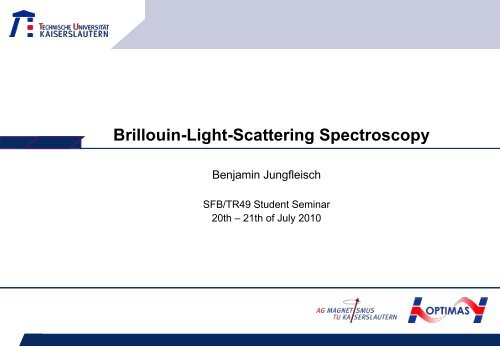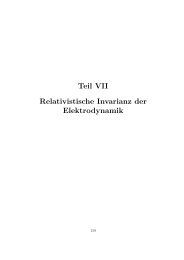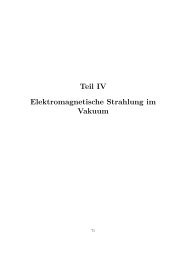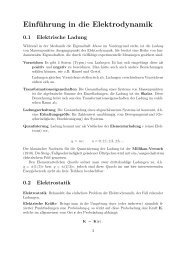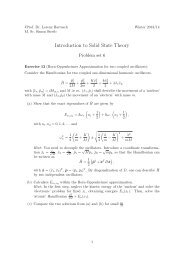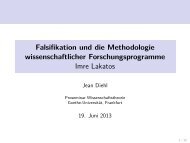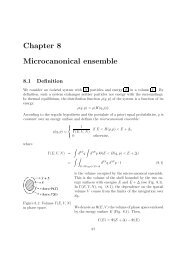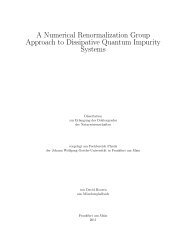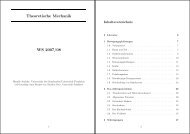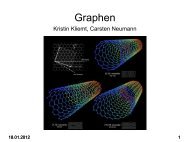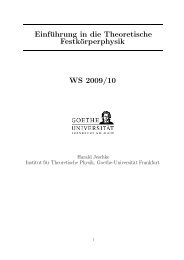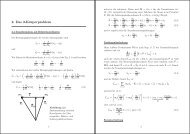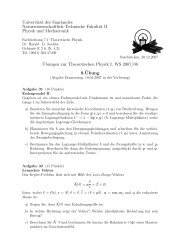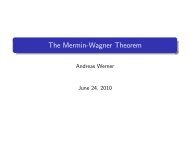Brillouin-Light-Scattering Spectroscopy
Brillouin-Light-Scattering Spectroscopy
Brillouin-Light-Scattering Spectroscopy
You also want an ePaper? Increase the reach of your titles
YUMPU automatically turns print PDFs into web optimized ePapers that Google loves.
<strong>Brillouin</strong>-<strong>Light</strong>-<strong>Scattering</strong> <strong>Spectroscopy</strong><br />
Benjamin Jungfleisch<br />
SFB/TR49 Student Seminar<br />
20th – 21th of July 2010<br />
Benjamin Jungfleisch SFB/TR49 Student Seminar 20th to 21th of July 2010
Content<br />
● Spin waves<br />
● <strong>Brillouin</strong> <strong>Light</strong> <strong>Scattering</strong> (BLS)<br />
• Quantum mechanical picture<br />
• Conventional experimental setup<br />
● Applications<br />
● Summary<br />
BLS<br />
• Time-resolved BLS<br />
• Phase-resolved BLS<br />
• Wavevector-resolved<br />
Benjamin Jungfleisch SFB/TR49 Student Seminar 20th to 21th of July 2010
Spin waves<br />
Benjamin Jungfleisch SFB/TR49 Student Seminar 20th to 21th of July 2010
asterformate durch Klicken bearbeiten<br />
e Ebene<br />
itte Ebene<br />
λ<br />
ierte Ebene<br />
Fünfte Ebene<br />
q<br />
Spin waves<br />
Landau-Lifshitz and Gilbert equation<br />
<br />
dM<br />
dt<br />
<br />
= −γ<br />
( M × H<br />
α<br />
) +<br />
M<br />
Benjamin Jungfleisch SFB/TR49 Student Seminar 20th to 21th of July 2010<br />
eff<br />
G<br />
s<br />
<br />
dM<br />
( M × )<br />
dt
q|| ⋅<br />
d<br />
H <br />
0<br />
Spin waves<br />
Distinction between different energy contributions<br />
• Exchange energy<br />
(generated by twist of neighbored spins, short range interaction)<br />
• Dipolar energy<br />
(generated by magnetic poles in long-wavelength spin waves, long range interaction)<br />
Benjamin Jungfleisch SFB/TR49 Student Seminar 20th to 21th of July 2010<br />
q <br />
H <br />
q <br />
q <br />
0<br />
H <br />
0
<strong>Brillouin</strong>-<strong>Light</strong>-<strong>Scattering</strong><br />
Benjamin Jungfleisch SFB/TR49 Student Seminar 20th to 21th of July 2010
Raman-<strong>Scattering</strong><br />
• Optical phonons<br />
• Molecule vibrations<br />
Frequencies up to several<br />
THz<br />
Grating spectrometer<br />
Inelastically scattered light<br />
<strong>Brillouin</strong>-<strong>Light</strong>-<strong>Scattering</strong><br />
• Acoustic phonons<br />
• Spin waves<br />
Frequencies below ~ 500 GHz<br />
Tandem Fabry-Pérot interferometer<br />
Benjamin Jungfleisch SFB/TR49 Student Seminar 20th to 21th of July 2010
<strong>Brillouin</strong>-<strong>Light</strong>-<strong>Scattering</strong><br />
Stokes: Anti-Stokes:<br />
Energy conservation law: ωs = ωi - ω ωs = ωi + ω<br />
Momentum conservation law: ks = ki - k ks = ki - k<br />
Benjamin Jungfleisch SFB/TR49 Student Seminar 20th to 21th of July 2010
Fabry-Pérot interferometer (FPI)<br />
The functionality of a Fabry-Pérot interferometer is based on<br />
multi-beam interference on two plane-parallel surfaces.<br />
The phase difference:<br />
⎛ 2π<br />
⎞<br />
Δϕ<br />
= ⎜ ⎟2nl<br />
cos( θ )<br />
⎝ λ ⎠<br />
Benjamin Jungfleisch SFB/TR49 Student Seminar 20th to 21th of July 2010
The transmittance function is given by:<br />
Fabry-Pérot interferometer<br />
Transmittance and reflectivity<br />
where R is the reflectivity and 4is<br />
Rthe<br />
coefficient of the finesse F.<br />
F = 2<br />
( 1−<br />
R)<br />
Maximum transmission occurs when<br />
m = 1,2,3,…<br />
T =<br />
1+<br />
R<br />
2<br />
2<br />
( 1−<br />
R)<br />
1<br />
=<br />
2<br />
− 2R<br />
cos( Δϕ)<br />
1+<br />
F sin Δ<br />
2nl cos( θ ) =<br />
mλ,<br />
( ) ,<br />
ϕ / 2<br />
Benjamin Jungfleisch SFB/TR49 Student Seminar 20th to 21th of July 2010
The free spectral range<br />
(FSR) is given by :<br />
2<br />
2<br />
λ0<br />
λ0<br />
Δλ<br />
=<br />
≈<br />
2nl<br />
cosθ<br />
+ λ 2nl<br />
cosθ<br />
The finesse F is given by:<br />
F<br />
F<br />
Δλ<br />
= =<br />
δλ<br />
π F<br />
≈<br />
2<br />
0<br />
π<br />
2arcsin<br />
π<br />
=<br />
1−<br />
R<br />
R<br />
( 1/<br />
F )<br />
Fabry-Pérot interferometer<br />
Our setup:F ≈ 110<br />
Benjamin Jungfleisch SFB/TR49 Student Seminar 20th to 21th of July 2010
Linear<br />
relation:<br />
Δν<br />
( Δl)<br />
= ν<br />
R<br />
Fabry-Pérot interferometer<br />
−ν<br />
=<br />
c<br />
λ<br />
Maximal transmission:<br />
R<br />
⎛<br />
⎜<br />
⎜ 1<br />
1−<br />
⎜ Δl<br />
⎜ 1+<br />
⎝ lR<br />
Benjamin Jungfleisch SFB/TR49 Student Seminar 20th to 21th of July 2010<br />
⎞<br />
⎟<br />
⎟<br />
⎟<br />
⎟<br />
⎠<br />
=<br />
c<br />
λ<br />
R<br />
l<br />
R<br />
l =<br />
Δl<br />
+ Δl<br />
m<br />
optical bandpass<br />
freuquency measurement<br />
⎛ Δl<br />
⎞<br />
λ(<br />
Δl)<br />
= λ ⎜ + ⎟<br />
R 1<br />
⎝ lR<br />
⎠<br />
≈<br />
λ<br />
2<br />
c<br />
λ<br />
R<br />
Δl<br />
l<br />
for lR= 0,3 mm: Δν= 500 GHz<br />
R
Operation of the TFPI<br />
Possibility to suppress higher orders.<br />
Benjamin Jungfleisch SFB/TR49 Student Seminar 20th to 21th of July 2010
Multi-pass tandem Fabry-Pérot<br />
interferometer (TFPI)<br />
• High contrast: more than 1:1010<br />
• High spectral resolution in the Sub-GHz-Regime (up to 50 MHz)<br />
• Accessible frequency range: 0,2 GHz – 500 GHz<br />
J. Sandercock, www.jrs-si.ch<br />
H. Schultheiß, www.tfpdas.de<br />
Benjamin Jungfleisch SFB/TR49 Student Seminar 20th to 21th of July 2010
λ<br />
Frequency Analysis<br />
BLS setup<br />
Active<br />
Stabilization<br />
+<br />
Positioning<br />
• optical resolution:<br />
up to 250 nm<br />
• 2D scanning stage<br />
• controlling sample position<br />
while measuring<br />
• frequency range:<br />
200 MHz – 1 THz<br />
• spectral resolution:<br />
up to 50 MHz<br />
• accuracy:<br />
better than 20 nm<br />
• high reproducibility<br />
Sample Stage<br />
Viewing System<br />
TFPDAS 4<br />
(www.tfpdas.de)<br />
by H. Schultheiss<br />
Benjamin Jungfleisch SFB/TR49 Student Seminar 20th to 21th of July 2010
Applications<br />
Benjamin Jungfleisch SFB/TR49 Student Seminar 20th to 21th of July 2010
1) Time resolution<br />
H. Schultheiss et al,<br />
J. Phys. D 41, 164017 (2008)<br />
2) Phase resolution<br />
A. A. Serga et al., APL 89, 063506 (2006)<br />
F. Fohr et al., RSI 80, 043903 (2009)<br />
3) Wavevector resolution<br />
C. Sandweg et al,<br />
Rev. Sci. Instrum. 81, 073902 (2010)<br />
2) 3)<br />
Applications<br />
Benjamin Jungfleisch SFB/TR49 Student Seminar 20th to 21th of July 2010<br />
1)
Applications:<br />
Time-resolved BLS<br />
Benjamin Jungfleisch SFB/TR49 Student Seminar 20th to 21th of July 2010
Time-resolved BLS<br />
Study the decay of spin waves<br />
and the dissipation processes<br />
H. Schultheiss et al,<br />
J. Phys. D 41, 164017 (2008)<br />
Benjamin Jungfleisch SFB/TR49 Student Seminar 20th to 21th of July 2010
Applications:<br />
Phase-resolved BLS<br />
Benjamin Jungfleisch SFB/TR49 Student Seminar 20th to 21th of July 2010
Phase-resolved BLS<br />
Inelastically scattered light contains phase information<br />
But: BLS signal is proportional to laser intensity<br />
I<br />
∝ x<br />
Idea: interference!<br />
2<br />
i(<br />
ωt<br />
+ϕ)<br />
2 2<br />
( t)<br />
= ( A⋅e<br />
) = A<br />
Superposition of the<br />
inelastic scattered<br />
light with a coherent<br />
reference beam with<br />
the same frequency.<br />
phase-information is lost!<br />
Benjamin Jungfleisch SFB/TR49 Student Seminar 20th to 21th of July 2010
phase resolved scan:<br />
Hext = 1846 Oe<br />
νRF = 7,125 GHz<br />
tpuls = 200 ns<br />
standard position scan:<br />
T. Schneider: PhD Thesis<br />
Example for phase-resolved BLS: Tunneling<br />
running spin wave: wave has not reached the barrier yet<br />
barrier (cut, 20 μm)<br />
λ/2<br />
YIG-film (1,6 x 7,7 mm)<br />
standing spin wave: wave is reflected back and forms<br />
a standing wave<br />
Benjamin Jungfleisch SFB/TR49 Student Seminar 20th to 21th of July 2010<br />
λ
Applications:<br />
Wavevector-resolved BLS<br />
Benjamin Jungfleisch SFB/TR49 Student Seminar 20th to 21th of July 2010
No translational invariance in z direction<br />
Only k|| = k sin(θ) conserved<br />
Maximum wavevector: k < 2.10 5 cm-1<br />
(Backscattering geometry: Δk = 2 k||)<br />
Wavevector-resolved BLS<br />
Benjamin Jungfleisch SFB/TR49 Student Seminar 20th to 21th of July 2010
Wavevector-resolved BLS<br />
Wavevector selection by rotating the sample<br />
C. Sandweg et al,<br />
Rev. Sci. Instrum. 81, 073902 (2010)<br />
Benjamin Jungfleisch SFB/TR49 Student Seminar 20th to 21th of July 2010
…wavevector<br />
resolved<br />
…time<br />
resolved<br />
Summary<br />
<strong>Brillouin</strong> light scattering<br />
study spin waves…<br />
…space<br />
resolved<br />
…frequency<br />
resolved<br />
…phase<br />
resolved<br />
Benjamin Jungfleisch SFB/TR49 Student Seminar 20th to 21th of July 2010


